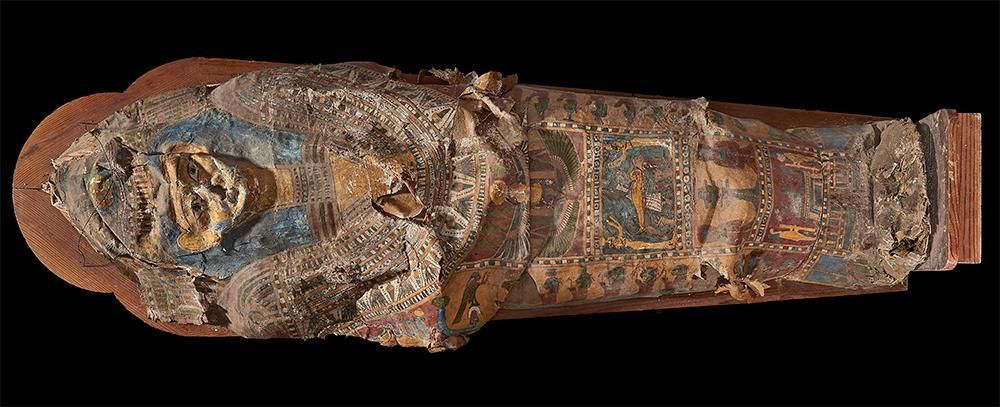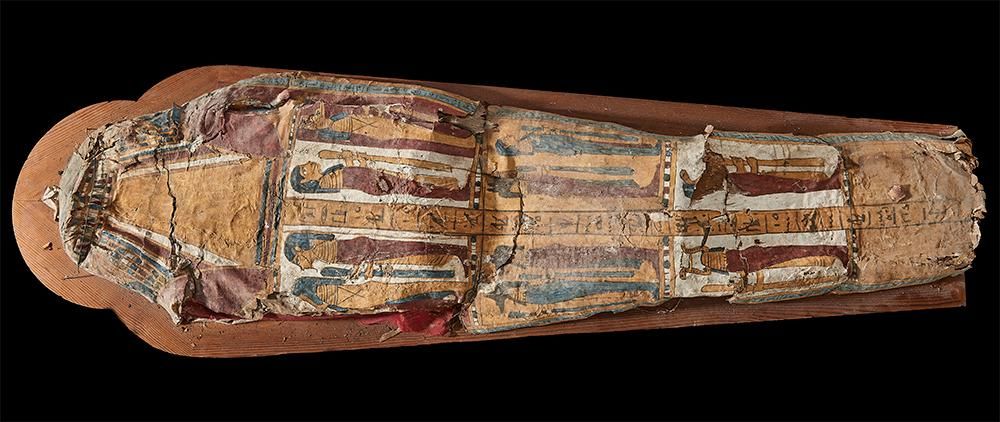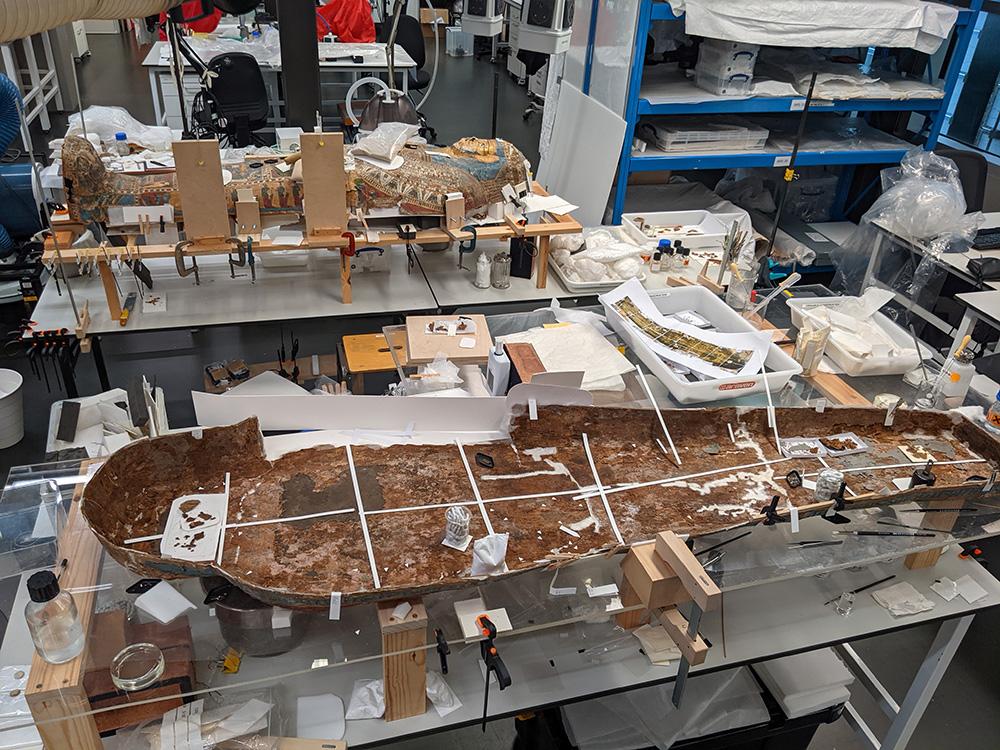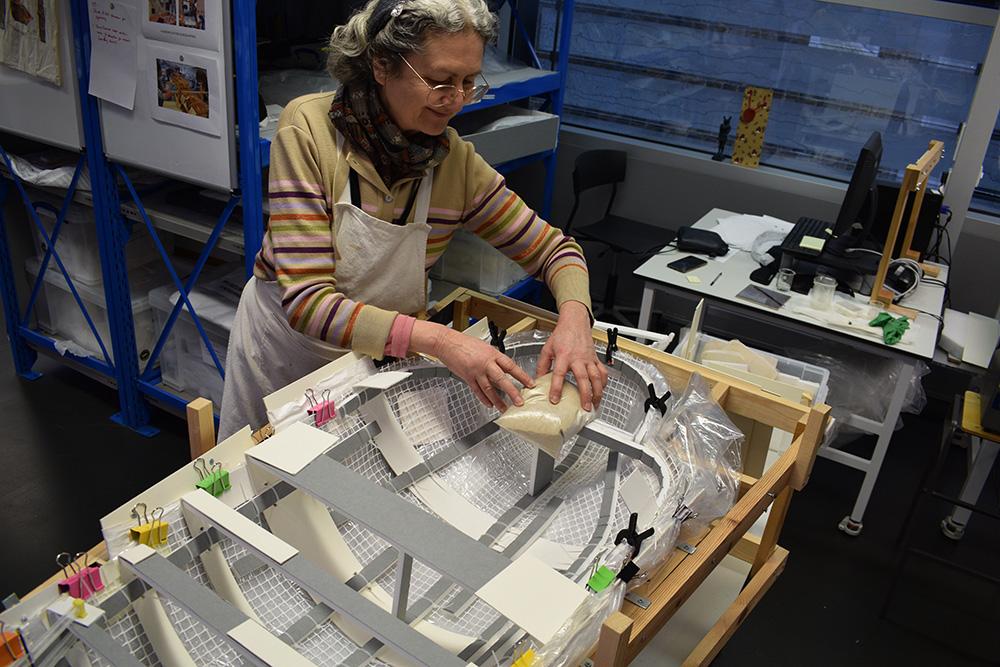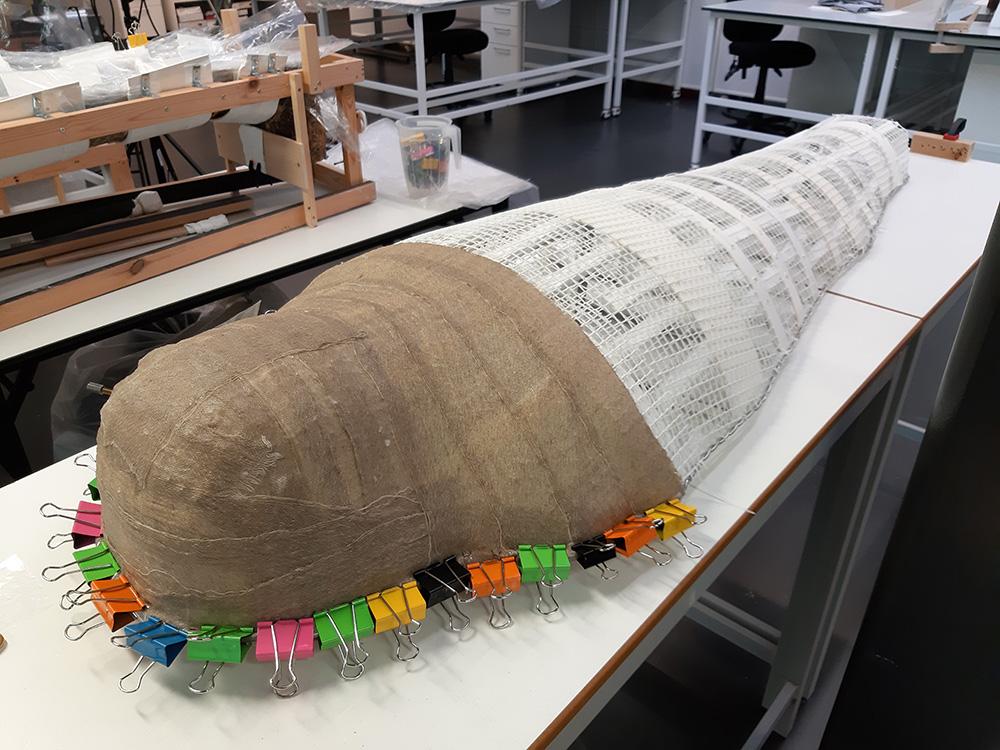Learn about the history and provenance of the Aswan cartonnage.
Conservators Verena Kotonski and Barbara Wills took on the challenge of conserving a unique 2,300-year-old ancient Egyptian coffin.
Over four years later, having used a host of techniques both ancient and new, the Aswan cartonnage coffin has now recovered its original shape and striking appearance.
Introduction
In ancient Egypt, coffins were made from a range of materials: wood, stone and even basketry. Some, however, were made of cartonnage – a remarkable, cardboard-like laminated material. Layers of textiles or papyrus, were stuck together with glue, wrapped over a human-shaped mould (called a 'former'), almost like ancient Egyptian papier mâché. A smooth gesso was applied to the surface which was then perfect for painting and gilding.
In 2018 the Museum acquired a remarkable cartonnage coffin. The coffin originally came from near Aswan in the Nile valley and dated to the Ptolemaic period (305–30 BC). It consists of a lid and a base and had once enclosed the mummy of an ancient Egyptian man. This cartonnage is unusual for several reasons, including the fact that it's a rare example of a traditionally Egyptian coffin from ancient Egypt's final period of Greek rule. Its excavation in 1907 and provenance are also very well documented, so there were good archaeological reasons to restore it to its former glory and put it on display. You can learn more about the coffin's history in this story.
Damaged and fragile
The past 2,000 or so years had, however, left their mark and it was in serious need of care and attention. Only on arrival at the Museum could we see the full extent of the damage. On the base, for example, the paint layer looked reasonably intact on the outside, however a modern piece of textile stuck to its interior disguised evidence of a severe insect attack. After the textile was removed, we saw that much original cartonnage had been lost and the overall structure was severely weakened. Then we discovered that many of the textile layers on both top and base were extremely degraded and brittle, in worse condition than anything we had ever encountered.
Although cartonnage is strong and lightweight it can break, become distorted, deformed and dented. It can also delaminate – come apart in layers – especially in damp conditions. In fact, exposure to damp had softened the cartonnage so much that over time it slumped under its own weight: the face had collapsed and there was a large fold in the middle of the lid. It no longer looked like a three-dimensional container that had once enclosed a mummy.
We were daunted, but excited: could we succeed in bringing it back, regaining its original shape? Little did we know that it would take three conservators over four years, and be one of the most challenging projects of our careers. We needed to use all our ingenuity, technical skill and perseverance. Often, we had to think on our feet, adapting existing methods and, where necessary, developing new ones. Happily, we could draw on the knowledge and experience of our colleagues in Conservation to discuss ideas and approaches.
What to do first? To remove distortions, several procedures were necessary and many of them had to be carried out simultaneously. We also had to make temporary support structures to aid reshaping as well as prepare a permanent support for the cartonnage to rest on after treatment.
Getting supports in place
To facilitate treatment, we needed to turn the lid and the base over from time to time to access both sides of the coffin. However, any movement would put strain on weak areas (such as tears and flaking paint) unless we provided a rigid support structure. We needed supports that could be adapted throughout the treatment, accommodate any changes to the shape – and allow us to access both the interior and exterior surfaces. Two different supporting frames were constructed, one following the internal shape of the lid and the other the external. Both included a number of adjustable cardboard arches, so that a single arch could be removed to enable access to a particular area for treatment as necessary. The internal frame was used in the early stages of reshaping the lid: this was fitted with metal hinges so that the width of the arches could be reduced, while the height was increased – as the cartonnage's shape was slowly restored.
Working out how to turn over the lid (given the size and fragility of the cartonnage coffin) made us think hard! This is where the external frame came into play. We built a wooden frame around the lid and connected the lid to the frame via two sets of padded cardboard arches, one set supporting the lid from underneath, the other set placed on top. Once the lid was securely sandwiched between the arches, the whole could be turned upside down. Both contraptions proved invaluable to facilitate the reshaping but also the mending of the many tears and weak areas.
Temporary support
Taking shape
Although humidity was a culprit in damaging the cartonnage, it could also help us to reverse the deformations – but this time in a very controlled manner. We created an enclosure around the cartonnage coffin using polythene sheeting and incrementally raised the relative humidity from 50% to 70–75% over the course of several months. The cartonnage became sufficiently supple for us to begin unfolding the creases, gently pushing and pulling it into shape. We succeeded in opening out the fold in the centre of the lid (a major milestone!) and the cartonnage slowly regained its original shape.
To mend tears and fill areas of loss, we used sheets of kozo (Japanese tissue paper, made from the bark of the mulberry tree) and Klucel G, a cellulose-based adhesive. In selected areas we decided to fill gaps and holes to restore strength to that area. To make these fills visually blend in, we pressed a piece of cloth into the surface of the paper pulp fill to imprint the textile weave.
Although the images in the excavation report provided some hints of the cartonnage's original shape, the most valuable clues came from the object itself. By mending the numerous tears, the structure started to slowly reveal itself, like a three-dimensional puzzle coming together. It was thrilling to watch it taking form before our eyes.
Reshaping and mending would not have been so successful without the many different methods we used to apply pressure or gently pull the two structures into shape. Shimbari struts made of high-density foam (an adaptation of a Japanese clamping technique) were great when we needed to apply pressure in a specific area from multiple angles. Our homemade wooden clamps also helped to carefully pull the lid into shape. Rare earth circular magnets (some of the strongest magnets available) were invaluable when used as clamps, applied in pairs to the interior and exterior to hold the repair in place until dry. Using these and other clamping techniques, we were able to carry out the many repairs hidden between the textile layers.
Reshaping and mending
Making the final support
Having spent all this effort – for a time, it felt infinite – in reshaping and repairing the cartonnage, we were aware that this success would be short-lived without an adequate long-term support for the lid and base. We explored a range of options, including manufacturing a support based on 3D-scanning technology but eventually settled on what we call a 'Buckram mount', an old-fashioned technique that creates a lightweight but supportive shell. First, the formers were made for the lid and base. Over these, linen strips soaked with wheat starch were pasted on in layers. Once dry, these rigid shells were covered with layers of soft, conservation-grade padding and fabrics. What struck us was that this technique was very similar to the construction method of the cartonnage coffin itself, and offered interesting insights into the challenges the ancient Egyptians must have faced. For example, the linen layers shrank and warped considerably during drying, something we had to take into account as our aim was to create supports that were as close to the cartonnage's original shape as possible.
The final reveal
It was an emotional moment, and the culmination of hundreds of hours of hard work, when we were finally able to place the conserved lid and base onto their new supports, ready for display. All involved would agree that it had been a momentous journey and a fantastic team effort. It was hugely rewarding to transform the cartonnage coffin to a close representation of how it would have originally looked.
Display
Acknowledgments
You can see the cartonnage in Egyptian death and afterlife: mummies (Room 62), The Roxie Walker Galleries, in case number 26.
If you would like to find out about the conservation of this cartonnage in more detail (we couldn't fit it all into this blog!), please head to our YouTube channel where you can find the film documenting this journey. You can also learn more about the history and provenance of the cartonnage in this story.
We would like to extend our heartfelt gratitude to conservator Helene Delaunay who contributed significantly to complete the conservation of the base, and to Dr John Taylor, for sharing his knowledge of ancient Egyptian funerary practices. We are most grateful to all our colleagues in Organics and Paper Conservation for giving us a helping hand whenever needed, with a particular thank you to senior textile conservator Monique Pullan. We also would like to thank producer Roux Malherbe who so skilfully captured this epic conservation story on film. We are grateful too for the generous support of the John S Cohen Foundation who funded the conservation and video documentation of this project.


